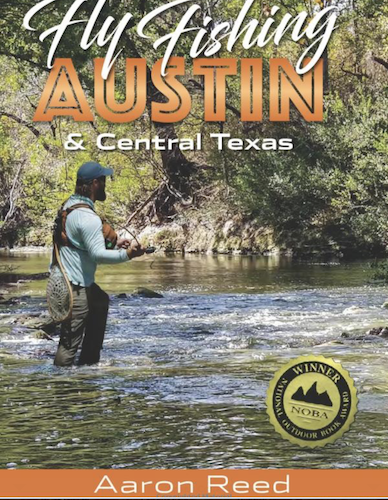Fly Fishing Austin and Central Texas- A Review
Fly Fishing Austin and Central Texas, by Aaron Reed. Imbrefex Books, Las Vegas, NV, 2020, paperback, 384 pages including index, $24.95.
My first impression upon handling Fly Fishing Austin was, “Wow, this book is stout.” The entire production oozes quality, from the paper stock, to the four-color reproduction, to the quality of the maps and images. The author and the publisher both did a great job producing a good-looking book.
That quality carries over into the text.
As you could expect in any fly-fishing guidebook, the first chapters tell you what to expect when you get there, what gear to bring, and what flies you need, including directions on how to tie them, or where to buy them if you choose not to tie. Unusual for a fishing guidebook, there are also playlists so you can get in that central Texas mood while you’re getting ready or travelling to the fishing spot.
A long chapter explains what you might find dangling from, or breaking, your leader. Did you know four species (or subspecies) of black bass call central Texas home? Or that North America’s only native cichlid is found here?
Three sections of the book divide central Texas into three fish-filled regions, with detailed instructions on how to find, access, and fish the waters found there. For example-
“This stretch of water can be fished before you get wet. The knee-to-thigh-deep pool between the bridges is littered with boulders, and the fish- sunfish and small bass, mostly- act like they’ve never been disturbed.
“About 1,000 feet upstream from this pool, above the old broken bridge, is the first really big pool. Formed behind a natural limestone ledge, the pool is 300 yards long and chest-deep at the tail. The ledges along the south bank hold fish, as does the vegetated shoreline on your right (river left). There are some big bass in here, as well as catfish. A wade in thigh-to-waist-deep water, right up the middle, beginning just above the bottom of the pool, will allow you to fish both banks.”
I found the details in the river descriptions borderline astonishing. A lot of on-the-water research went into the making of this book. At the end of each fishing spot description a page or two describes a local watering hole (or two!) where you might find some microbrew and barbeque. It’s a nice touch!
A chapter describes the joy you receive from taking children fly fishing.
Another chapter describes, in surprising detail, the flora and fauna you’ll encounter while tramping around central Texas waters. Pages describing colorful local history are sprinkled throughout the work.
Appendices include local fly shops, fly clubs, guides, and liveries, as well as stream access points by latitude and longitude. And the book is indexed, a feature I find very helpful. And there’s a few pages “For Further Reading,” although unless you’re a scholar I don’t know why you’d need that!
I have never considered central Texas as a fishing destination. After reading Fly Fishing Austin and Central Texas I want to go there. This is a great book, and a must-read for any fly-fisher considering making a trip to central Texas.
-John Kumiski

Speak Your Mind